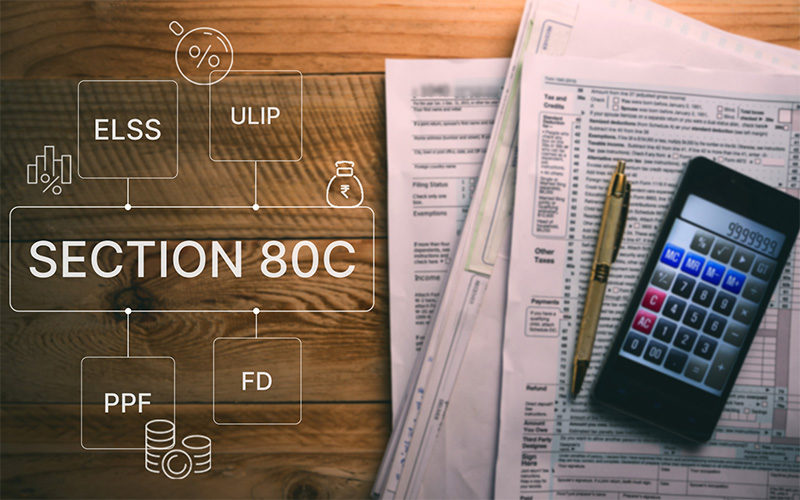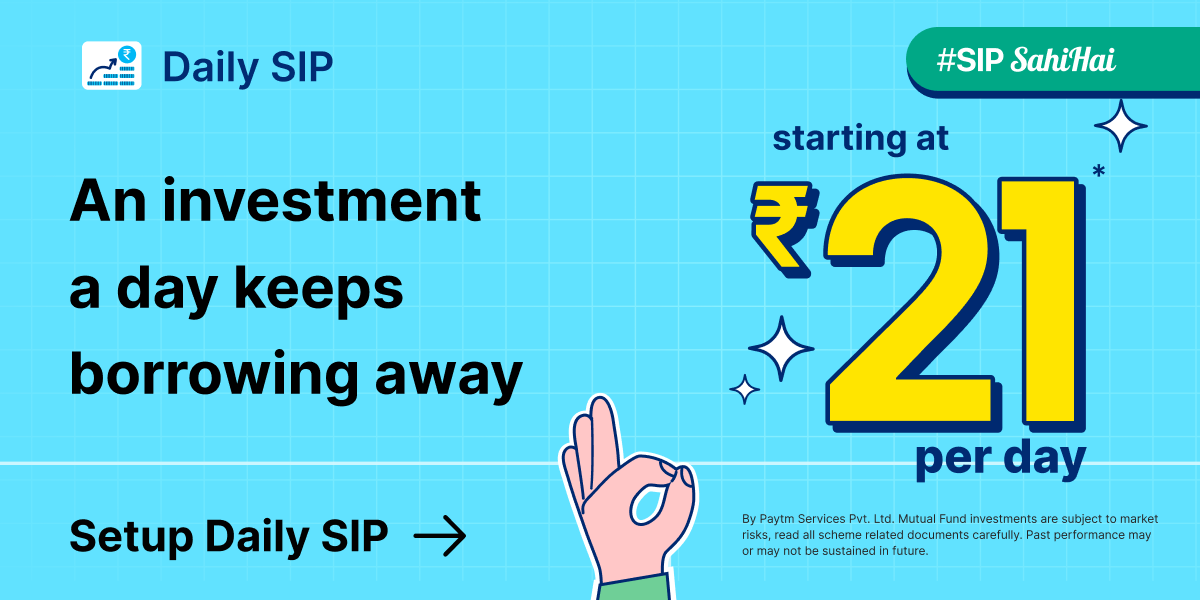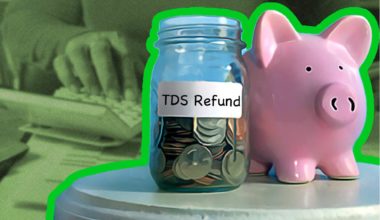Section 80C of the Income Tax Act is a rule that lets you save on taxes by investing in certain things or spending on specific expenses. It’s like a tax-saving opportunity. When you make these investments or spend on eligible items, you can reduce the amount of income that is taxable. This means you end up paying less in taxes. Some examples of eligible things include life insurance premiums, contributions to employee provident funds, tuition fees, home loan repayments, and investments in schemes like Public Provident Fund and National Savings Certificates. This blog will explain Section 80C in detail, including the maximum deduction limit and important things to consider when using it to save taxes and manage your finances better.
Table of Contents Show
What is Section 80C of Income Tax Act?
Section 80C of the Income Tax Act is a provision that allows individuals to reduce their taxable income by claiming deductions on certain investments and expenses. This provision aims to promote savings and investments for long-term financial security.
Some popular investment options under Section 80C include life insurance premiums, contributions to the Employee Provident Fund\ (EPF), investments in the Public Provident Fund (PPF) and National Savings Certificates (NSC), tuition fees, repayment of home loan principal, and investments in Equity-linked Saving Scheme (ELSS) mutual funds.
It’s important to note that the maximum deduction limit under Section 80C is Rs. 1.5 lakh. By utilizing these deductions wisely, individuals can lower their tax liability while securing their financial future.
Investments Deductible Under Section 80 C of the Income Tax Act
Here are some tax-deductible investment options under Section 80C. They not only assist you in saving taxes, but they also assist you in growing your money. The following is a quick comparison of the options that offer a deduction under Section 80C:
| Investment | Maximum Deduction Limit | Lock-in Period | Associated Risks |
|---|---|---|---|
| Life Insurance Premiums | Rs. 1.5 lakh | Throughout policy term | Risk of policy lapsing if premiums are not paid regularly. |
| Employee Provident Fund (EPF) | Rs. 1.5 lakh | Till retirement | No major risks involved. |
| Public Provident Fund (PPF) | Rs. 1.5 lakh | 15 years | Interest rate fluctuations and liquidity constraints. |
| National Savings Certificate (NSC) | Rs. 1.5 lakh | 5 years | No major risks involved. |
| 5-year Fixed Deposit with Banks | Rs. 1.5 lakh | 5 years | Low interest rates and limited liquidity. |
| Sukanya Samriddhi Yojana | Rs. 1.5 lakh | Till the child turns 21 years | No major risks involved. |
| Senior Citizen Savings Scheme | Rs. 1.5 lakh | 5 years | Low interest rates and limited liquidity. |
| Tax-saving Fixed Deposit | Rs. 1.5 lakh | 5 years | Low interest rates and limited liquidity. |
| Equity Linked Savings Scheme (ELSS) | Rs. 1.5 lakh | 3 years | Market-related risks and volatility. |
| Tuition Fees for Children | Rs. 1.5 lakh | NA | No major risks involved. |
| Repayment of Home Loan | Rs. 1.5 lakh | NA | Risk of property value depreciation or foreclosure in case of default. |
| Principal Component of Home Loan EMI | Rs. 1.5 lakh | NA | Risk of property value depreciation or foreclosure in case of default. |
Note: Please note that the lock-in periods mentioned above are approximate and may vary based on specific terms and conditions of each investment. Additionally, the associated risks mentioned are general in nature and may vary based on market conditions and individual circumstances. It is advisable to consult with a financial advisor before making any investment decisions.
Read More: Complete Procedure for Income Tax e-Filing
Tax Saving Options under Section 80C of Income Tax Act
1. Public Provident Fund
If you invest in the Public Provident Fund (PPF), you can get tax benefits under Section 80C of the Income Tax Act. You can deposit a maximum of Rs. 1,50,000 in a PPF account, and the entire amount can be claimed as a tax exemption. This means you don’t have to pay taxes on that deposited amount. Additionally, if you are an employee and make voluntary contributions to the provident fund, those contributions are also tax deductible under Section 80C.
Are you looking for a reliable and tax-efficient way to grow your savings? Explore the benefits of Public Provident Fund (PPF) and take control of your financial future today!
In our comprehensive PPF guide, you’ll discover:
- The key features of PPF and how it works.
- Tax benefits and exemptions available with PPF.
- Tips for maximizing your PPF account’s returns.
2. Unit-Linked Insurance Plans (ULIPs)
ULIPs, which stands for Unit-Linked Insurance Plans, are insurance policies that give you two benefits in one. They provide you with insurance coverage to protect you and your loved ones, and at the same time, they allow you to invest your money in different types of funds like stocks, bonds, or a mix of both. ULIPs are popular because they have the potential to give you higher returns compared to regular insurance policies. They also come with tax benefits, meaning you can save on taxes by investing in them.
3. NABARD Rural Bonds
NABARD Rural Bonds are an attractive tax-saving option available under Section 80C of the Income Tax Act. These bonds, issued by the National Bank for Agriculture and Rural Development (NABARD), allow individuals to invest in rural development projects while enjoying tax benefits. By investing in NABARD Rural Bonds, individuals can reduce their taxable income by the amount invested, up to the limit of Rs 1.5 lakh. This not only helps in saving taxes but also supports rural development initiatives such as agricultural loans, rural infrastructure projects, and entrepreneurship programs. It’s a win-win situation, as investors can contribute to the growth of rural areas while enjoying tax savings.
When you buy life insurance and pay the premiums, it can help you save on taxes. Under Section 80C of the Income Tax Act, the money you spend on life insurance premiums can be deducted from your taxable income. This means that the amount you pay for life insurance can be subtracted from the total income you have to pay taxes on. It’s a way to reduce the amount of tax you owe. So, by getting life insurance, you not only protect your loved ones but also get a tax benefit.
5. Senior Citizens Savings Scheme
The Senior Citizens Savings Scheme (SCSS) is a government-backed savings scheme for individuals aged 60 years and above. It offers a fixed tenure of 5 years, extendable by 3 years, with an attractive interest rate. Investments in SCSS are eligible for tax benefits under Section 80C, up to a maximum of Rs 1.5 lakh. The scheme provides a safe and reliable investment option for senior citizens to earn regular income during their retirement years, with a maximum investment limit of Rs 15 lakh per individual.
6. National Savings Certificate
The National Savings Certificate (NSC) is a government-backed savings scheme in India that offers a fixed interest rate and tax benefits. It has a 5-year maturity period, with the interest rate set by the government. Investing in NSC qualifies for tax deductions under Section 80C, making it a safe and attractive option for long-term savings.
7. Tax Saving Fixed Deposits
Tax Saving Fixed Deposits (FDs) are a type of fixed deposit offered by banks that provide tax benefits to investors. These FDs have a lock-in period of 5 years and offer a fixed interest rate, ensuring a stable return on investment. The interest earned on Tax Saving FDs is taxable, but investors can claim deductions under Section 80C of the Income Tax Act, up to a maximum limit of Rs 1.5 lakh. This makes Tax Saving FDs a popular choice for individuals looking to save taxes while earning a guaranteed return on their investment.
8. Equity-Linked Savings Scheme
Equity-Linked Savings Scheme (ELSS) is a type of mutual fund in India that offers both tax benefits and the potential for higher returns. ELSS funds primarily invest in equity markets, providing investors with an opportunity to participate in the growth potential of stocks. Investments in ELSS qualify for tax deductions under Section 80C, up to a maximum limit of Rs 1.5 lakh. ELSS funds have a lock-in period of 3 years, which is the shortest among tax-saving investment options. This makes ELSS a popular choice for individuals seeking tax-saving instruments with the potential for wealth creation through equity investments. However, it’s important to note that ELSS funds are subject to market risks, and returns are not guaranteed.
9. Sukanaya Samridhi Yojana
Sukanya Samriddhi Yojana (SSY) is a government-backed savings scheme in India specifically designed for the girl child. It aims to promote the welfare and education of girls and provides a long-term savings option for their future expenses, such as education and marriage. Under this scheme, parents or legal guardians can open an account for a girl child below the age of 10. The account has a tenure of 21 years or until the girl gets married after the age of 18. SSY offers an attractive interest rate, which is compounded annually and is currently higher than most other savings instruments. Investments in SSY are eligible for tax benefits under Section 80C, with a maximum investment limit of Rs 1.5 lakh per financial year. The scheme provides a secure and reliable investment avenue, ensuring financial security and empowerment for the girl child.
“Secure your daughter’s future with Sukanya Samriddhi Yojana”
10. Infrastructure Bonds
Section 80C of the Income Tax Act allows for tax exemptions on infrastructure bonds if the investment is equal to or greater than Rs. 20,000. The Rs. 1.5 lakh limit still applies to these long-term secured bonds.
Read More: Income Tax Slab Rate
How to Avail Tax Deduction Under 80C?
Step 1: Identify Eligible Investments
Recognize investments and expenses that qualify for deductions under Section 80C. This includes options like PPF, EPF, NSC, life insurance premiums, and more.
Step 2: Calculate Total Investments
Add up all the amounts invested in eligible options during the financial year. The maximum deduction limit is Rs. 1,50,000.
Step 3: Choose Suitable Investments
Select investments that align with your financial goals and risk tolerance. Consider diversifying to maximize tax benefits.
Step 4: Keep Documentation
Maintain records and receipts for all Section 80C investments, including life insurance premium payments, PPF passbooks, and relevant documents.
Step 5: File Income Tax Return
Report eligible investments made under Section 80C when filing your income tax return. Fill out the necessary details in the ITR form.
Step 6: Claim the Deduction
Deduct the invested amount (up to Rs. 1,50,000) from your total taxable income. This reduces your overall tax liability, leading to potential savings.
Step 7: Stay Updated with Tax Laws
Regularly check for any changes in tax laws, especially regarding Section 80C limits or eligible investments, to optimize your tax benefits.
Step 8: Seek Professional Advice
For complex financial situations or uncertainty about investment choices, consult a tax advisor or financial planner for personalized guidance.
Note: The following steps are provided as a general guideline for availing tax deduction under Section 80C. It is important to note that the availability and eligibility of investments may vary based on individual circumstances, financial goals, and changes in tax laws. Please consult a tax professional or financial advisor to assess your specific situation and receive personalized advice on maximizing your tax benefits.
How Much Can Be Claimed Under Section 80C Deduction?
Under Section 80C of the Indian Income Tax Act, an individual can claim a deduction of up to Rs. 1,50,000. This means that you can reduce your taxable income by up to Rs. 1,50,000 by investing in eligible options like PPF, EPF, NSC, life insurance premiums, and more. It is important to note that this deduction limit is applicable per financial year.
Let’s say you have a total taxable income of Rs. 5,00,000 for the financial year. You have invested Rs. 1,50,000 in eligible options under Section 80C, such as a PPF account and payment of life insurance premiums.
In this case, you can claim a deduction of up to Rs. 1,50,000 from your taxable income. So, your taxable income will be reduced to Rs. 3,50,000 (Rs. 5,00,000 – Rs. 1,50,000).
Based on the applicable income tax slab rates, you will be taxed on the reduced taxable income of Rs. 3,50,000. This will result in potential tax savings as the tax liability will be calculated on the lower taxable income amount.
It is important to note that the maximum deduction limit under Section 80C is Rs. 1,50,000. If you have invested more than this amount, you can only claim a deduction up to the limit.
Eligibility of Sec 80C of Income Tax Act
| Eligibility Criteria | Details |
|---|---|
| Eligible Individuals | Resident individuals and Hindu Undivided Families (HUFs) |
| Specific Investments |
|
| Lock-in Period | Certain investments have a minimum lock-in period during which funds cannot be withdrawn |
| Maximum Deduction Limit | Rs. 1.5 lakh in a financial year |
| Relation to Income | Deductions claimed should not exceed the individual’s total taxable income |
| Documentation | Maintain proper documentation and records of investments and expenses under Section 80C |
How to Maximize Tax Saving under Section 80C?
To maximize your tax savings through deduction under Section 80C, it’s important to understand the available options and the limits. Here’s how to make the most of it:
- Utilize the maximum deduction limit of Rs. 1.5 lakh: Make sure to take full advantage of the deduction limit by investing up to the maximum amount allowed under Section 80C.
- Plan investments wisely: Choose the financial instruments that offer the best tax benefits and align with your financial goals. Popular options include PPF, EPF, NSC, tax-saving fixed deposits, and life insurance premiums. Evaluate the returns, lock-in periods, and risks associated with each option before making a decision.
- Spread investments across different options: Diversify your investments across multiple eligible instruments instead of putting all your money into a single option. This helps to manage risks and optimize returns.
- Consider long-term investments: Some investments, like PPF, have a long lock-in period. By starting early and consistently contributing over time, you can maximize tax benefits and accumulate a substantial corpus.
- Plan expenses strategically: Apart from investments, certain expenses like tuition fees for children and repayment of home loan principal also qualify for deductions under Section 80C. Ensure that you claim deductions for all eligible expenses to maximize your tax savings.
- Start tax planning early: Begin your tax planning early in the financial year to have sufficient time for informed decisions. This helps avoid last-minute rush and allows you to make the most of available deductions.
- Keep track of documentation: Maintain proper documentation and records of all investments and expenses made under Section 80C. This includes keeping receipts, certificates, and other relevant documents to support your tax claims.
Disclaimer: Nothing on this blog constitutes investment advice, performance data or any recommendation that any security, portfolio of securities, investment product, transaction or investment strategy is suitable for any specific person. You should not use this blog to make financial decisions. We highly recommend you seek professional advice from someone who is authorised to provide investment advice.










